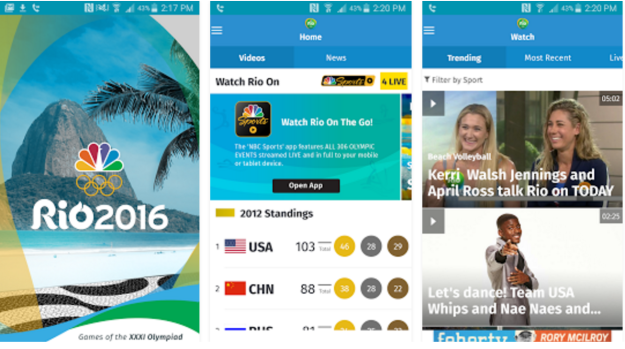Stamford Spotlight, Part 4: NBC Olympics’ Streaming Factory Evolves With Viewing Habits
This is Part Four of SVG’s four-part series on NBC Olympics’ ‘at-home’ operation in Stamford, CT. Make sure to check out Part 1, an overview of the operation as a whole; Part 2, focused on the studios and control rooms; and Part 3, on the “Off-Tube Factory” commentary operation.
NBC Olympics’ Streaming Factory, a novelty back in 2012, is a well-oiled machine in 2016 and arguably the most important contributor to the Games’ success: for the first time, more viewers are choosing to watch online than on linear television. And, with plans to stream 4,700 hours of coverage by the end of the Games — up from 1,000 for the 2014 Sochi Olympics and 3,500 for the 2012 London Games — the Stamford, CT.-based Streaming Factory has evolved into quite the complex operation.
“What’s great, from four years ago to today, is just the volume of content that we’re doing as NBC Sports Group,” says Eric Black, CTO, digital, NBC Sports Group. “When you look at four years ago, we had a partnership with YouTube in how we were delivering video. … We also weren’t in this [Stamford] facility. And I think we’ve evolved, too, [looking] at how much content we’re pushing out on a day-to-day basis: we’ll do 15,000 events this year. We weren’t doing that four years ago.”

By the end of Rio 2016, NBC Sports will have streamed 4,700 hours of both live coverage and full-event replays.
With ambitious plans to provide both live and full-event replays of all 34 sports at Rio 2016, NBC Olympics relies heavily on OBS host feeds for its streaming coverage. NBC takes in both OBS host feeds and the IP VandA package, encodes them using the H.264 standard, and wraps the feeds as MPEG-2 transport streams at 19 Mbps. NBC also acquires MDS feeds (voiced versions of the competitions), which are acquired as baseband signals and encoded onsite at the IBC as IP multicast streams.
More than 100 sources are sent to the U.S. on fully redundant multiple paths, with most going directly to Stamford. From Stamford, streaming feeds are fed via Level 3 circuits to Microsoft in Ashburn, VA, and iStreamPlanet in Las Vegas.
“The idea is, in fact, redundancy, but also, if you’re dealing with a really high-load event, we can spread some of that across different origin centers,” explains Black. “You can break up your traffic based on platform — look at desktop, mobile, maybe put connected on a different path — so you’re keeping caches warm against both of those. You don’t want to take a few million of X and dump them onto a few million of Y that wasn’t expecting it, because that can cause some potential problems.”
An iStreamPlanet CMS interface allows NBC’s ad-operations/insertion team to insert variable-length ad markers into the live stream. FreeWheel will deliver the ads to live streams, full-event replays, and short-form VOD assets on devices where ads are supported.
NBC relies on SnappyTV’s LiveCut Editor to create the highlights that can be published within minutes to various platforms, enabling the editorial team to create quick highlights and video snippets. Akamai serves as the CDN for delivery of all live and VOD streams to users.
“Microsoft, Adobe, Akamai: these are the partners that we’re using for Super Bowl; these are the partners that we used for [Sochi 2014]. It’s the same partners; we just keep evolving the stack,” says Black. “As time goes on and we onboard new platforms, we’re just evolving our technology stack.”
In addition to streaming more hours than ever, Black’s team is charged with delivering those streams to more devices than from either London 2012 or Sochi. For the first time, NBC is streaming to connected TVs — Apple TV, Roku, and others — as it continues to adapt to the ever expanding amount of available mobile devices.
“It’s a lot of first-time devices,” says Black. “Right before the Olympics, we had just launched Win10, we had just launched Chromecast, and we just launched Samsung. So you’ve got a lot of new devices there as well. These are things that we’re looking forward to offering as part of NBC Sports Group on an ongoing basis.
“We’ll continue to explore other devices in the future,” he continues, “but it’s a challenge: each device obviously has its own [way of playback]. Live is definitely still a different animal than VOD. And how the content’s playing back, plus some of our requirements around how we’re conditioning the streams. It’s challenging; it’s a little bit more on the QA cycles and making sure you’ve got it just right.”
Fans streaming the Rio Olympics on their mobile devices, desktops, and connected TVs are also experiencing another “first”: the ability to stream the primetime broadcast. According to NBC, there are more tie-ins between the broadcast shows, streaming events, and VOD assets, and a noticeable cohesion between the broadcast and digital teams.
“When you start to look at cohesiveness between broadcast and digital, and the linear and digital workflows, we’re using the same tools that we use every day,” Black points out. “It’s the same thing that we use for NHL that we’re using for Rio that we’re going to use for Premier League that we’re going use for NFL. All we’re really doing is extrapolating. That’s what I think is making this a very, very successful event and will continue to make all our events very successful. We have a very cohesive bond between broadcast and digital.”
